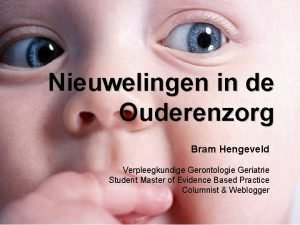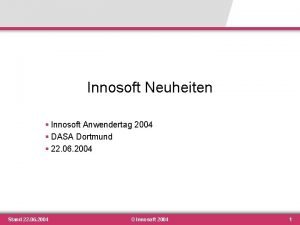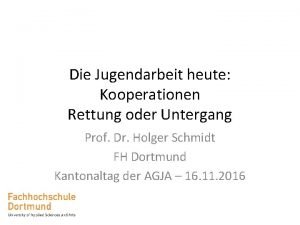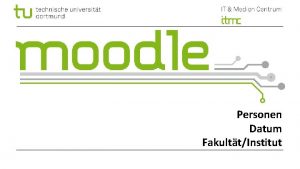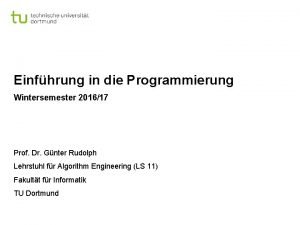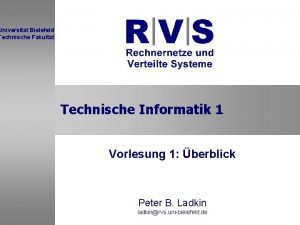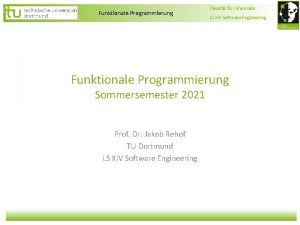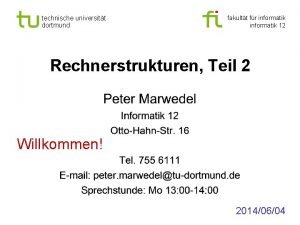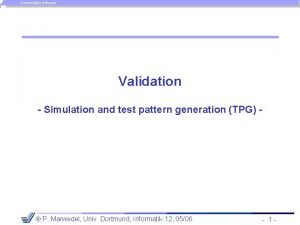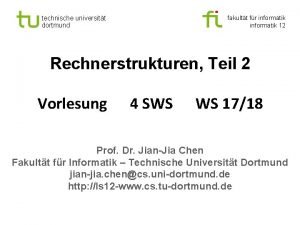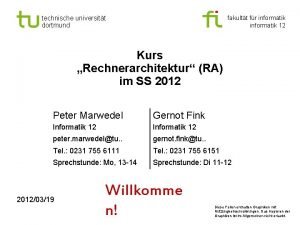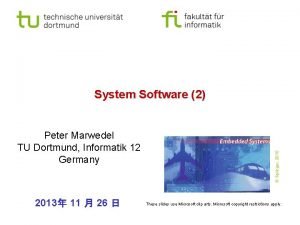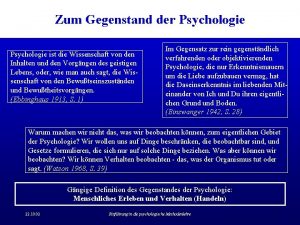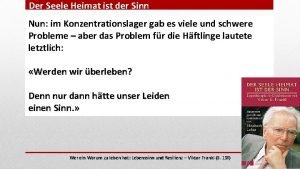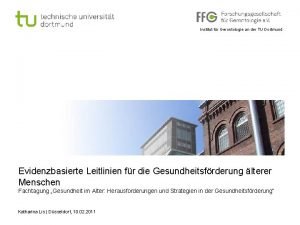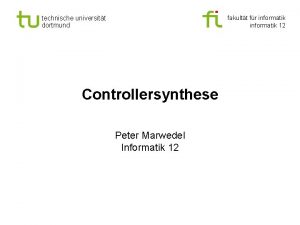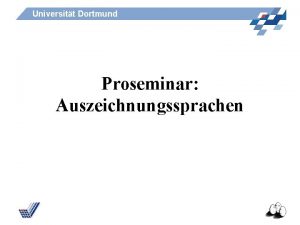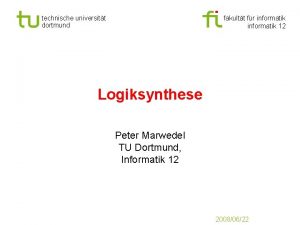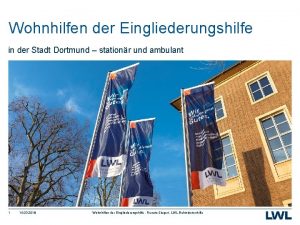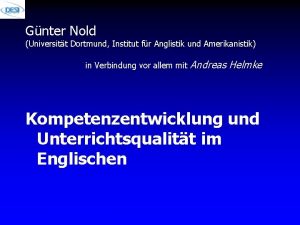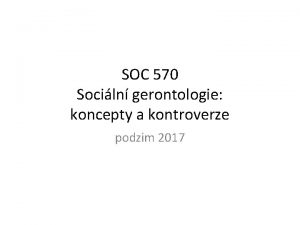Institut fr Gerontologie an der TU Dortmund Dr

































- Slides: 33

Institut für Gerontologie an der TU Dortmund Dr. Jürgen Bauknecht | Dr. Vera Gerling Germany: Company schemes of Bayer AG, Deutsche Post/DHL and Deutsche Bahn Expert Workshop. Extending working lives through flexible retirement schemes. Focus: partial retirement Eurofound, Brussels, April 8 2016

Institut für Gerontologie an der TU Dortmund Structure (1/2) I Bayer 1. 2. 3. 4. 5. 6. 7. The company: Facts and figures Context of the collective agreement Implementation of collective agreement at Bayer Current arrangements: Employee attitudes Goals and employees´ assessment of measures Conclusion / summary 2

Institut für Gerontologie an der TU Dortmund Structure (2/2) II Deutsche Post/DHL 1. 2. Old-age part-time scheme Assessment (first version: Interviews yesterday afternoon) III Deutsche Bahn 1. 2. Old-age part-time scheme Assessment IV Discussion: Employers´ motivation 3

Institut für Gerontologie an der TU Dortmund 1. Bayer AG: Facts and figures § Since January 1, 2016: Bayer has 3 divisions: Pharmaceuticals, Consumer Health and Crop Science; Animal Health as separate segment Spin-offs § Covestro (2015): Plastics (Bayer share: 69%) § Lanxess (2004): Chemicals (no Bayer shares, but joint venture Currenta 60% Bayer and 40% Lanxess) Acquisition § Schering (2006): Pharmaceuticals Employees § Worldwide 117 000, Germany 37 000 (high share in Germany between 50 and 60) 4

Institut für Gerontologie an der TU Dortmund 2. Context of collective Agreements § Bayer belongs to chemical industry, therefore collective agreements with trade union IG BCE (Industriegewerkschaft Bergbau, Chemie, Energie; Industrial Union Mining, Chemistry, Energy) § Collective agreement 2012 („Working Life and Demography“) strongly influenced by Bayer (both from the sides of the board of managers as the employee representation). After BASF (112 000 / 50 000 employees) Bayer is the 2 nd largest company in the sector (Bayer CEO chairman of employers´ organisations) § Main element of collective agreement from 2008: establishment of „Demography Fund“ § Collective agreement 2012 advanced collective agreement from 2008 (also called „Working Life and Demography“) Source: IGBCE 2012 5

Institut für Gerontologie an der TU Dortmund 2. Context of collective Agreements Demography Fund Possibilities (amongst others) § Improving old-age part-time work § Upgrading long-term accounts Ø Implementation differed on the level of the companies (respectively decided by the management of the company and the employee representation) Source: IG BCE 2012 6

Institut für Gerontologie an der TU Dortmund 2. Context of collective Agreements: Collective agreement 2012 § Reduction of working time to adjust to special life phases and to find ways for a gradual transition to retirement § New element: „Reduced Full-Time 80%“. Can be used for various reasons, e. g. child-rearing or flexible retirement (after 60): Working time reduced by 20 per cent while full wage is paid § „Reduced Full-Time 80%“ can be combined with “old age spare time” (the latter usually allows 2, 5 paid spare hours per week per employee aged 57 working in day shift) § Demography Fund's available resources paid into a company longterm account Source: IGBCE 2012 7

Institut für Gerontologie an der TU Dortmund 3. Implementation of collective agreement at Bayer (1/2) § The five Bayer company agreements for the implementation of the collective agreement reach far beyond the two sector-wide collective agreements § Main company agreements: § 2007: Company agreement concerning long-term account, further developed in 2014 § 2010: Company agreement „Working Life and Demography“ (Demo 1): Employer contribution of € 300 per full-time worker: Can be used e. g. for old-age part-time 8 Source: Interviews with Müller, HR leader for Germany & Zühlke, head of the employee representation, March 2016

Institut für Gerontologie an der TU Dortmund 3. Implementation of collective agreement at Bayer (2/2) § 2013 (Demo 2): 2010 agreement further developed, including additional € 200, to be used e. g. for RV 80, or old-age part-time or long-term accounts 9 Source: Interviews with Müller, HR leader for Germany & Zühlke, head of the employee representation, March 2016

Institut für Gerontologie an der TU Dortmund 4. Current arrangements (1/5): 2015 agreement: Combination of „Reduced Full-Time 80%“ and “Old age spare time” and long-term account § Solidarity model financed by the Demography Fund In 2016 Bayer contributes € 550 per full-time worker (2017: € 750) § Focus on two target groups with special workload situations: (1) employees in fully continuously shift work aged 55+ (2) employees in day work aged 57+ § Employees in full continuously shift work aged 55+: 20 days. When turning 60: 25 days and when turning 63: 30 days. Since working time in the 5 -shift system (the most common form) is 35. 9 hours, this results in a 4 -day week (from 55 on). 10 Source: Interviews with Müller, HR leader for Germany & Zühlke, head of the employee representation, March 2016

Institut für Gerontologie an der TU Dortmund 4. Current arrangements (2/5): § Employees in day work aged 57+: Same as above, yet due to a higher number of weekly working hours this results in a 4. 5 -dayweek (from 57 on). § Agreement e. g. that long-term account can be used for additional reductions of the number of working hours per week: Combination of RV 80, old-age spare time and individual long-term account can result in 3 -or 4 - day weeks (individual long-term account see below) § Bayer agreement reduces minimum age suggested by collective agreement (60) by 5 years (to 55) § Approx. 1, 500 employees under the collective agreement use this model of paid reduction of work burden (approx. 94%) 11 Source: Interviews with Müller, HR leader for Germany & Zühlke, head of the employee representation, March 2016

Institut für Gerontologie an der TU Dortmund 4. Current arrangements (3/5): Re-integration after long sickness § Employees falling ill for at least 120 calendar days without interruption: disburdening integration: Up to 80 hours of paid leisure time (80% - 86% participate in that scheme) 12

Institut für Gerontologie an der TU Dortmund 4. Current arrangements (4/5): Indiviudal long-term Account “Bay. Zeit” (1/3) § 2007: Installation of long-term account; further development in 2014 by company agreement. § Used by approx. 40% of all employees (percentage rising with age and wage level). Rising share of employees willing to make use of account in future times (9% of questioned employees in 2009 vs. 14% in 2015) § Can be filled with interest-bearing money (such as salaries or bonuses) or time (valued in money, such as remaining vacation days or overtime. Lower salary groups even better supported with special monetary system § Phase of exemption: release (also in part-time) i. e. care for close relatives or to reduce workload, take part at qualification measures or earlier retirement 13 Source: Interviews with Müller, HR leader for Germany & Zühlke, head of the employee representation, March 2016

Institut für Gerontologie an der TU Dortmund 4. Current arrangements (4/5): Individual long-term Account “Bay. Zeit” (2/3) § Biggest benefit from employees´ view: To retire earlier (more than 50% of all questioned employees) or to take care of close relatives (approx. 30%) § If Bay. Zeit is being taken, additional modules for old age provision will be granted § Using the long-term account, employees have more money in the end 14 Source: Interviews with Müller, HR leader for Germany & Zühlke, head of the employee representation, March 2016

Institut für Gerontologie an der TU Dortmund 4. Current arrangements (4/5): Individual long-term Account “Bay. Zeit” (3/3) § February 2015: long-term account can be used in combination with other models – leading to even more reduced workload (3 or 4 day weeks). Preconditions: sufficiently filled long-term account; usage of a reduction of working hours within Demo 1 or Demo 2 § Example calculation: If a full-time worker (with 37. 5 working hours per week) wants to change to a 4 -days working week, he or she must only finance 16 days out of the long-term account. This is about half of the working time reduction. The rest is financed by the employer (company fund) 15 Source: Interviews with Müller, HR leader for Germany & Zühlke, head of the employee representation, March 2016

Institut für Gerontologie an der TU Dortmund 4. Current arrangements (5/5): ‘Healthy Working and Ageing at Bayer’ Considerable health programme (not specified here) Holistic company approach from recruitment to retirement: § Occupational health management § Improvement of work station ergonomics § Modern organisation of shift plans (five-shift-system, short changes of shift, free weekends, predictable and regular regulations) § Labour organisation adjusted to health situations § Implementation of new human resources concepts § Reconciliation of Family and Work Life (e. g. flexible working time) 16 Source: Interviews with Müller, HR leader for Germany & Zühlke, head of the employee representation, March 2016

Institut für Gerontologie an der TU Dortmund 4. Current arrangements (5/5): Care of close relatives Overall agreement (April 1 st 2014) § Advice about nursing care § Short-time not paid exemptions for care activities up to 10 days § Long-term exemptions for up to six months in the frame of an inactive work relationship § So-called Pflegezeitkonto (“care account”) Ø 8% of questioned employees at Covestro that care for a relative, make usage of measures (9% of questioned employees at new Bayer). No differences between men and women (but women tend to care more hours) 17 Source: Interviews with Müller, HR leader for Germany & Zühlke, head of the employee representation, March 2016

Institut für Gerontologie an der TU Dortmund 5. Current Arrangements: Employee attitudes (1/4) § Comparing employee surveys from 2009 and 2015 § General satisfaction with Bayer as employer: overall satisfaction on similar high levels in 2009 and 2015: (81% / 80% of all questioned employees were very satisfied or rather satisfied) § Subjective work requirements: An increasing share of workers considers work as more complicated and demanding than two years ago (2009: 60%, 2015: 67%) 18 Source: Interviews with Müller, HR leader for Germany & Zühlke, head of the employee representation, March 2016

Institut für Gerontologie an der TU Dortmund 5. Current Arrangements: Employee attitudes (2/4) § Pace of work and increasing work intensification: employees have a great demand to reduce their pace of work and their work intensification; has strongly increased between 2009 and 2015 (3 from 22% to 32%) § Job loss: employees of Bayer feared less to lose their jobs in 2015 than in 2009 (17% instead of 31%. Fears higher in less qualified groups and at Covestro) 19 Source: Interviews with Müller, HR leader for Germany & Zühlke, head of the employee representation, March 2016

Institut für Gerontologie an der TU Dortmund 5. Current Arrangements: Employee attitudes (3/4) § Presentism: Within the last year, - Nearly half (47%) of employees reported that they held out until the weekend to recover from sickness at least twice - Nearly half (43%) of employees went to work although they felt really sick at least twice § Health status: Common U-shaped age pattern due to selfselection into the group of oldest workers 20 Source: Interviews with Müller, HR leader for Germany & Zühlke, head of the employee representation, March 2016

Institut für Gerontologie an der TU Dortmund 5. Current Arrangements: Employee attitudes (4/4) Satisfaction with the solidarity model: § For 59% of employees it is absolutely OK and should be even expanded further that certain employees such as those being older, sicker, working in shifts or earn less are more taken into consideration by Bayer § 33 % of employees agree with that model but do not think it should be further expanded → 92% of all employees support the solidarity model 21

Institut für Gerontologie an der TU Dortmund 6. Goals and employees´ assessments of measures § Two reasons to set up the programme “Working Life and Demography”: § programme aims at self-determination of employees to be able to cope with the different phases of burdens that occur in ones life § due to increasing statutory retirement age, programme aims at supporting employees to work as healthy as possible § Employee surveys in general confirm the approach of Bayer (source: head of the employee representation) § Too early and too hard to answer whether Bayer has reached its goals, but “right track” (HR-leader of Germany) 22 Source: Interviews with Müller, HR leader for Germany & Zühlke, head of the employee representation, March 2016

Institut für Gerontologie an der TU Dortmund 7. Conclusion / summary § Approach: Bayer has installed a programme reaching far beyond the collective agreements. The implementation of the programme was supported by the management board and the employee representation. § Goals: For Bayer it is important to enable employees to work until statutory retirement age as employees still retire some years earlier. Thus, the various schemes aim at higher employability. § Acceptance by employees: The general approach of Bayer, especially the solidarity model, is highly agreed upon by employees (according to surveys) 23 Source: Interviews with Müller, HR leader for Germany & Zühlke, head of the employee representation, March 2016

Institut für Gerontologie an der TU Dortmund II Deutsche Post/DHL (Interviews yesterday postponed, information based on preliminary information provided by Deutsche Post/DHL) 1. Old-age part-time scheme § Old-age part-time: Reduction of working time to 50% of the normal working time with between 79% and 87% of the previous wage (higher percentages for low-earners). § Can e. g. be used for six years and then the prior to official retirement paid leave is possible due to savings in the working time account 24

Institut für Gerontologie an der TU Dortmund II Deutsche Post/DHL § Background: A high share of workers, especially those delivering mail and parcels, suspects to be unable to work until legal retirement age: Mail / parcels are heavy and weather conditions are unfavourable (e. g. snow). Programme focused on the 80 000 mailmen. § Motivation: - To shift work to younger workers - „Especially older workers want to continue to work yet want to reduce weekly working hours“ (company statement) 25

Institut für Gerontologie an der TU Dortmund II Deutsche Post/DHL Formal preconditions § § § After 6 years or earlier the legal retirement age can be reached A saved-up ‚Value Credit‘ of at least 55 points (e. g. with parts of the wage) Tenure of at least 5 years Unlimited employment contract End (retirement) laid down in the contract Non-formal precondition § Deutsche Post points out that putting such models into practice is very complicated, given the large number of affected actors and the 26 need to advise employees

Institut für Gerontologie an der TU Dortmund II Deutsche Post/DHL 2. Assessment § Funding from Demography fund (annual company contribution of € 200 per year and fulltime worker, 2013). Additional employer contributions to pension fund. § Secondary employment with earnings of up to € 450 allowed § Usage: Old-age part-time: 3 600 employees (March 2016), mainly those with physically demanding jobs. 21 000 employees have a long-term working time account (incl. younger workers, cohorts from 1950 to 1995 § 90% of users deliver mail and/or parcels § Old-age part-time can be combined with a working-time savings account, so that by using a „release phase“ from the savings account, also old-age part-time workers can retire before the legal retirement age → the possibility to convert parts of the wage into non-working time could reduce labour supply 27

Institut für Gerontologie an der TU Dortmund III Deutsche Bahn 1. Old-age part-time scheme § Collective demography agreement with two trade unions (EVG, Gd. L) § Programme „Special part-time in old age“ (since 2013) allows workers to use 45 „regeneration shifts“ (i. e. free working days) per year and thereby to reduce their working time to 81% of the normal working time with about 88% of the normal wage § Preconditions - minimum age at 60 - tenure of at least 20 years - at least 10 years in rotating shifts or - at least 80 hours per year between 8 pm and 6 am or - in on-call duty or 28 - none of this due an assessment by a company doctor

Institut für Gerontologie an der TU Dortmund III Deutsche Bahn 1. Old-age part-time scheme Several forms of working time reduction. The 45 days can be used § - as ‚Block Leisure Time‘, that is, in holiday planning. Deutsche Bahn prefers this model since the effect on relaxation is probably bigger planning is more easy than with § - as single working free days or a ‚de-facto 4 -day-week‘ (trade union EVG) § - only as an exception and only in regard to in individual cases and their circumstance a complete block model can be used with free working days immediately before retirement → the model offered by Deutsche Bahn is less generous than at Bayer 29 or Deutsche Post/DHL and strongly targeted at older workers (60+) with a long tenure of shift work.

Institut für Gerontologie an der TU Dortmund III Deutsche Bahn 2. Assessment → possibly effects on labour supply are more positive (or less negative) since - Due to targeting on those with harsh working conditions for a long time, possibly a comparatively high share of workers would quit otherwise for health reasons - Financial attractiveness possibly low enough so as not to attract too many workers who do not need it 30

Institut für Gerontologie an der TU Dortmund IV Discussion: Employers´ motivation (1/2) § If old-age part-time prolongs workings lives and therefore raises older worker employment rates (extensive margin), the effect on the total number of working hours is positive only if this effect is stronger than the loss of weekly working hours (intensive margin): Full-time from 60 to 64 is more working hours than half-time from 60 to 66. § Effects depend on what part-time workers would have done otherwise (full-time or retirement) § It is not clear if and to which degree companies are interested in a higher number of hours worked by older workers § Several programmes are part of collective agreements. Companies´ contributions are part of the package deal, that is, the normal general wage rise is smaller due to companies´ contributions to demography funds 31

Institut für Gerontologie an der TU Dortmund IV Discussion: Employers´ motivation (2/2) § If older workers´ work performance is below the median earner – which is possible in physically demanding jobs – then due to demography funds employers wage costs decline and in turn they get a lower number of working hours by a group with sub-median work performance and above-median number of sickness days § Possibly rather union-supported benefit for older workers than proemployment measure § Possibly part-time work raises the number of working hours if strongly targeted on those who would completely drop out of the labour market if the part-time scheme would not be available. The model at Ddeutsche Bahn focusing on older long-term shift workers and providing weak financial incentives comes closest to this. § Yet further developments depend on employers´ motivation to raise the number of older working hours. Here (de facto) seniority 32 pay and other determinants of labour demand could matter.

Institut für Gerontologie an der TU Dortmund Contact Dr. Jürgen Bauknecht Coordinator research area ‚Emplyoment, Business and Technology‘ Research Asociation for Gerontology / Institute of Gerontology at TU Dortmund University Evinger Platz 13, 44339 Dortmund, Germany jbauk@post. tu-dortmund. de ++49 (0) 231 728 488 15 http: //www. ffg. tu-dortmund. de/cms/en/Team/Koordination-der. Forschungsbereiche/Juergen_Bauknecht. html 33
 Geriatrie a gerontologie rozdíl
Geriatrie a gerontologie rozdíl Bram hengeveld
Bram hengeveld Innosoft einsatzplanung
Innosoft einsatzplanung Eini tu dortmund
Eini tu dortmund Holger schmidt fh dortmund
Holger schmidt fh dortmund Ostrzenski dortmund
Ostrzenski dortmund Ews tu dortmund
Ews tu dortmund Wgh dortmund
Wgh dortmund Studentensekretariat tu dortmund
Studentensekretariat tu dortmund Pikas uni dortmund
Pikas uni dortmund Technische lego
Technische lego Ub dortmund
Ub dortmund Dortmund arbeitslosenquote
Dortmund arbeitslosenquote Retina tu dortmund
Retina tu dortmund Rvs tu dortmund
Rvs tu dortmund Funktionale programmierung tu dortmund
Funktionale programmierung tu dortmund Zubair khan dortmund
Zubair khan dortmund Thermico dortmund
Thermico dortmund Rechnerstrukturen tu dortmund
Rechnerstrukturen tu dortmund Dortmund pattern
Dortmund pattern Rechnerstrukturen tu dortmund
Rechnerstrukturen tu dortmund Rechnerarchitektur tu dortmund
Rechnerarchitektur tu dortmund Lsf fh dortmund
Lsf fh dortmund Technische informatik definition
Technische informatik definition Srp tu dortmund
Srp tu dortmund Michael karagounis
Michael karagounis Alexandra nolte
Alexandra nolte Brandschutzpiktogramme
Brandschutzpiktogramme E3t tu dortmund
E3t tu dortmund Technische graphics
Technische graphics Georg heym der gott der stadt text
Georg heym der gott der stadt text Gegenstand der psychologie beispiel
Gegenstand der psychologie beispiel Erste tag der woche
Erste tag der woche Der seele heimat ist der sinn
Der seele heimat ist der sinn

